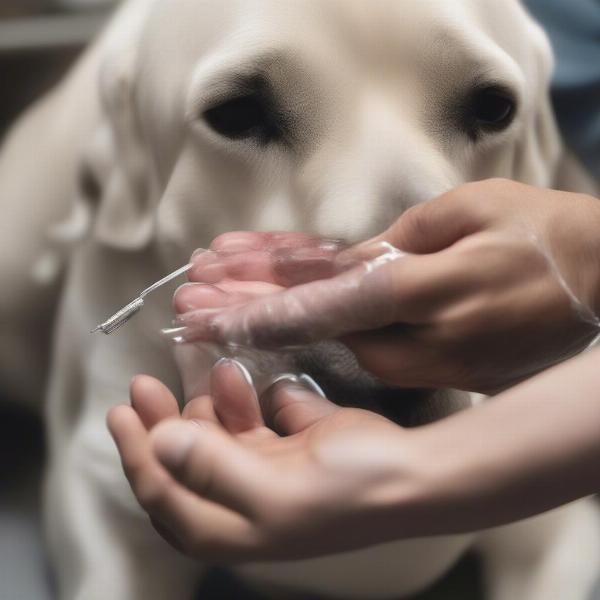Paraphimosis in dogs is a serious condition where the penis, once extended, cannot retract back into the prepuce (foreskin). This can lead to pain, swelling, and even tissue damage if left untreated. While some cases of mild paraphimosis in dogs may respond to home treatment, it’s crucial to understand when professional veterinary intervention is necessary. This article will guide you through recognizing paraphimosis, exploring potential home treatments, and understanding when to seek urgent veterinary care.
While attempting home treatment for mild cases can be considered, it’s essential to monitor your dog closely and consult a veterinarian if the condition doesn’t improve quickly or worsens. The goal of home treatment is to reduce swelling and lubricate the penis to facilitate retraction. However, attempting forceful retraction can cause further injury and pain, so gentle handling is crucial. Remember, prompt veterinary attention is always the safest approach for paraphimosis in dogs.
Recognizing Paraphimosis in Your Dog
Paraphimosis presents as a visibly extended penis that is unable to retract. The exposed penile tissue will appear swollen, red, and possibly dry or discolored. Your dog may lick excessively at the area due to discomfort and irritation. In severe cases, the penis may become dark or bluish due to restricted blood flow.
Home Treatment Options for Mild Paraphimosis
If the paraphimosis is mild and the penis appears only slightly swollen and not discolored, you can try applying a lubricant like sterile KY Jelly or a sugar-based solution to the penis. This can help reduce friction and make retraction easier. Gently attempt to push the penis back into the prepuce while applying consistent, gentle pressure. Do not force it.
 Applying lubricant to a dog's penis for paraphimosis.
Applying lubricant to a dog's penis for paraphimosis.
When to Seek Veterinary Care for Paraphimosis
If the penis appears severely swollen, discolored (dark red, purple, or blue), or if your attempts at home treatment are unsuccessful, immediate veterinary attention is critical. Delayed treatment can lead to irreversible damage to the penis, including tissue necrosis. Your veterinarian will likely administer anti-inflammatory medications to reduce swelling and may perform manual reduction of the paraphimosis under sedation or anesthesia. In severe cases, surgical intervention may be required.
Understanding the Causes of Paraphimosis
Several factors can contribute to paraphimosis, including trauma, infections, hair rings constricting the penis, and certain medical conditions. Knowing the underlying cause is essential for effective treatment and prevention.
Is Paraphimosis a Medical Emergency?
Yes, paraphimosis can become a medical emergency, especially if left untreated. The longer the penis remains exposed, the greater the risk of complications, including tissue damage and infection.
Conclusion: Prompt Action is Key for Paraphimosis in Dogs
Paraphimosis in dogs requires careful assessment and prompt action. While home treatment may be appropriate for mild cases, it’s crucial to seek veterinary care if the condition doesn’t improve quickly or worsens. Early intervention can prevent serious complications and ensure your dog’s comfort and well-being.
FAQ:
- What is the first thing I should do if I notice paraphimosis in my dog? Immediately contact your veterinarian for advice.
- Can I prevent paraphimosis in my dog? Regular grooming, especially around the genital area, can help prevent hair rings and reduce the risk of paraphimosis.
- Is paraphimosis painful for dogs? Yes, paraphimosis can be very painful for dogs due to swelling and inflammation.
- Can paraphimosis recur in dogs? Yes, especially if the underlying cause is not addressed.
- Are certain breeds more prone to paraphimosis? Breeds with long hair or excessive skin folds around the prepuce may be at higher risk.
- What are the long-term complications of untreated paraphimosis? Untreated paraphimosis can lead to permanent damage to the penis, including scarring and loss of function.
- How long does it take for paraphimosis to resolve with treatment? This varies depending on the severity of the condition and the treatment approach.
Related Articles on ILM Dog:
ILM Dog is your trusted international resource for expert dog care advice. We offer a wealth of information on dog breeds, health, training, nutrition, grooming, and much more, catering to both novice and experienced dog owners worldwide. Whether you need help choosing the right breed, understanding your dog’s health needs, or finding the best products and accessories, ILM Dog is here to support you every step of the way. For any inquiries, reach out to us via email at [email protected] or call us at +44 20-3965-8624. We’re dedicated to helping you provide the best possible care for your canine companion.